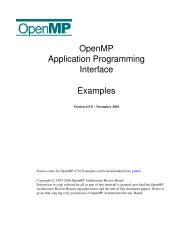D2 3 Computing e-Infrastructure cost calculations and business _models_vam1-final
D2 3 Computing e-Infrastructure cost calculations and business _models_vam1-final
D2 3 Computing e-Infrastructure cost calculations and business _models_vam1-final
You also want an ePaper? Increase the reach of your titles
YUMPU automatically turns print PDFs into web optimized ePapers that Google loves.
e-‐FISCAL: www.efiscal.eu <br />
EC Contract Number: 283449 <br />
peak loads) could be justified by the additional revenues or other benefits (such as increased user satisfaction <br />
leading to improved retention of clients). <br />
On the other end of the scale, in case the utilisation rate of the in-‐house infrastructure is very low (e.g. 10%), it is <br />
most likely a good idea to consider outsourced solutions. However, there are two issues to consider in the <br />
process: <br />
• What the actual savings potential is <strong>and</strong> when it can be realised. Avoiding the purchase of new servers brings <br />
in savings, however some investments (e.g. related to building a server room) tend to be sunk <strong>cost</strong>s, i.e. <br />
impossible to recover despite early decommissioning. In case the sunk <strong>cost</strong>s dominate, studying the ways the <br />
productive utilisation rate of the in-‐house infrastructure could be increased might be useful alternative <br />
strategy. For example contributing resources for educational or charitable purposes is a relatively common <br />
marketing strategy that could be applied. <br />
• Whether the outsourced solution fulfils all the functional <strong>and</strong> non-‐functional requirements, <strong>and</strong> whether lack <br />
of in-‐house infrastructure will have a negative impact on staff motivation <strong>and</strong> skills, or on development, <br />
training <strong>and</strong> support activities. For technical performance, consider benchmarking. <br />
Considerations for an organisation using (mainly) Cloud resources the situation is perhaps slightly more <br />
straightforward. Investing in in-‐house IT infrastructure makes sense in situations where there is sufficient volume <br />
<strong>and</strong> it is possible to identify a baseline load that seems to remain stable. The potential benefits are most obvious <br />
in cases where the volume of activity is very high <strong>and</strong> the <strong>business</strong> model of the organisation makes <strong>cost</strong> of service <br />
provision critical in terms of competitiveness or profitability. <br />
The case of in-‐house IT infrastructures that fall into neither of the extremes require case by case analysis that <br />
usually needs a broader analysis than just review of <strong>cost</strong>s of different options. <br />
5.7.2 Cost structure, its heterogeneity <strong>and</strong> size of the infrastructure<br />
The e-‐FISCAL study indicated that OPEX <strong>cost</strong>s dominate, with the personnel <strong>cost</strong>s typically being the largest <br />
category. In the e-‐FISCAL material this was true even in large scale infrastructures (although other studies have <br />
shown cases of large-‐scale installations where the personnel <strong>cost</strong>s have been a relatively minor <strong>cost</strong> category). <br />
Based on the results, scaling up may sometimes brings in economies of scale, however, case-‐by-‐case analysis is <br />
important. Once moving beyond very limited IaaS offering with (explicitly) minimal support contract, the actual <br />
applications <strong>and</strong> services provided may change the <strong>cost</strong> per core hour considerably (i.e. difference between <br />
offering IaaS solution <strong>and</strong> IaaS offering with support <strong>and</strong> consulting). Especially when launching new services or <br />
entering new markets, it may be difficult to estimate how much of additional manpower is needed in marketing, <br />
user support <strong>and</strong> consulting to gain critical mass. Based on literature review switching to an outsourced solution <br />
does not seem to bring in major savings in manpower expenditure, even on relatively “technical” management <br />
tasks. <br />
The ambiguous results of the “economies of scale” analysis as well as lack of demonstrated dramatic manpower <br />
savings may be indications of the relatively low maturity level of the IaaS marketplace. St<strong>and</strong>ards <strong>and</strong> best <br />
practices are evolving quite rapidly <strong>and</strong> “st<strong>and</strong>ard categories of use cases” are still in the process of forming, <br />
leading to uncertainty <strong>and</strong> management overhead on the “client side”. Development in these areas should be <br />
monitored, as they may change the <strong>cost</strong> structure of outsourced solutions while at the same time making the <br />
overall <strong>cost</strong>s more predictable. <br />
e-‐FISCAL : Financial Study for Sustainable <strong>Computing</strong> e-‐<strong>Infrastructure</strong>s <br />
Deliverable <strong>D2</strong>.3 – <strong>Computing</strong> e-‐<strong>Infrastructure</strong>s <strong>cost</strong> estimation <strong>and</strong> analysis – Pricing <strong>and</strong> <br />
Business <strong>models</strong> <br />
76




